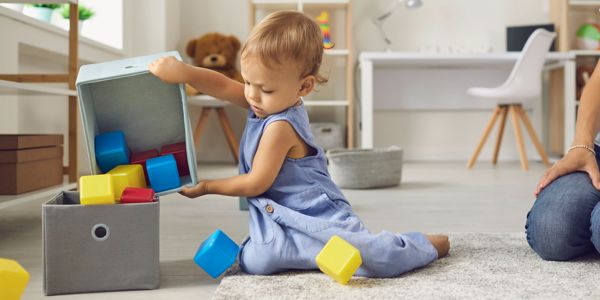Foster parents share a unique shared experience – the moment when you get “the call.”
"The call" is when a child enters the foster care system and needs a place to stay. Qualified foster parents who have availability are contacted to see if they would be willing to take the placement. Most foster parents I know will universally say “yes.” At this point, they will have a limited amount of time to prepare their home to welcome a new child who has been uprooted from their own home and familiar surroundings.
Foster homes are still homes, and regardless of how long, or short, your foster child’s stay will be, you want them to feel welcome and comfortable. For the well-being of foster children, who are being uprooted from everything familiar, it is essential that the home they are being placed into feels safe. While there’s no universal way to ensure this, there are some things you can do to increase the likelihood of the child(ren) feeling welcome.
Living Areas
Tidy Up
While your home doesn’t need to be spotless, a messy home can give a child the impression that they are walking into a chaotic environment which does not promote a feeling of safety and security. On the flip side, hyper-organizing your home can also be intimidating as it could lead the child to feel like they will be reprimanded for “messing up” a system you have set in place.
Newcomer’s Perspective
Setting up your home in a way that is intuitive to someone who hasn’t been there before can be beneficial in allowing the child to find things on their own and not have to come to you for help if they don’t feel comfortable. This will also give them confidence in feeling like they belong and not like an outsider who needs to constantly ask where things are or permission before helping themselves. Ex: Place extra rolls of toilet paper under the bathroom sink, your silverware drawer near the dishes, etc.
Create Welcoming Spaces
While their bedroom will most likely be their main safe space and where they may spend the majority of their free time, setting up spaces with purpose can encourage the child to be comfortable in the main living areas as well. This may look like setting up a reading nook in the living room with a bean bag or setting out some coloring books and crayons on the kitchen table.
Bedroom
Consider Their Age
To create a space that truly feels like their own, make an effort to add some age-appropriate touches. While babies will not mind what their room looks like, toddlers, children, and teens may appreciate the effort. Ex: Board books for toddlers, story books for children, and chapter books for teens.
Avoid Gender Stereotypes
Opting for gender-neutral designs will ensure that each child can put their own personal touches on the space without having to adjust for any extremes they don’t personally identify with.
Avoid The Comparison Trap
If you have other children in your home, ensure that there aren’t significant disparities between their spaces and the new child’s. This will help avoid feelings of favoritism, or territorial arguments. Ex: If you have a T.V. in one bedroom, add one to the other bedroom as well.
Rules & Procedures
Setting a Routine with Flexibility
A routine can provide the necessary structure and support during an unfamiliar transition. However, it is equally important to allow for flexibility as too much structure may be unfamiliar and feel confining. For example, you may want to have set meal times but also have a collection of snacks that are readily available at all times.
Chore Charts
For older children and teens, having a “job” in the home can give the child purpose and help them feel included, but only as long as everyone else has a job too. Avoid assigning overwhelming chores like entire rooms and stick to simple tasks such as unloading the dishwasher or taking the trash out. Be mindful that some children may have drastically different experiences so allow ample time for learning and growth, emphasizing that chores are a way to help and contribute, never a punishment or requirement for being a part of the family. You may even want to pair up chores so the child can learn alongside you or another family member and experience some bonding time as well.
Bedtime
While sleep is critical, especially for growing children who are processing a significant life change, it may be difficult in the beginning. Some children may not want to be alone, or have a hard time falling asleep. Utilizing a bedtime routine will help children know what to expect night after night as they settle into their new normal.
Essentials
Toiletries
Having a variety of travel-sized toiletries on hand for unexpected foster placements and then shopping for full-sized products once you have assessed their needs and preferences may be your best option. For babies and toddlers, you will most likely be safe with whatever tear-free shampoo and soaps you usually get, but some children will have allergies you will want to be aware of. For older children and teens, there can be strong preferences for toiletries like toothpaste flavors, deodorant scents, and even make-up brands. Waiting to learn these preferences before fully stocking up can save you from having a lot of wasted products.
Clothing
The child may be coming to you with limited clothing, possibly only the clothes they are wearing if the placement is sudden. Babies and small children may not be as picky about their clothing so you can gather a small wardrobe before they arrive. For older children and teens, having a few basics like t-shirts, lounge pants, pajamas, underwear and socks in their size is a good idea to start with. Taking them shopping once they’ve settled in will help ensure they have clothes that fit their own personal style. You may also consider providing them with a small gift card so that they can shop online for a few special staples that fit their comfort level.
Food
Many children in foster care have experienced food scarcity and may feel the need to hoard food at meals to ensure they are not hungry later. They may also be unfamiliar with the meals your family typically eats, especially if they are culturally specific, so including some classics they may have encountered before, like boxed macaroni, in your menu with a few side options can be beneficial. Providing access to healthy snacks (and even a few treats) without limitation can bring a sense of ease.
Security
Remove Potential Dangers
Even if the child is older, it’s a good idea to keep medications, chemicals, or any potentially dangerous items secured away. This will most likely be a requirement during the home study that qualifies you to foster, but doing a double-check is a good idea.
Bedroom Door Lock
Having a door that locks from the inside on the child’s door allows them to have a small measure of control and security, should they feel the need to utilize it. This also affords them privacy as necessary, especially if there are other children in the home who may not respect personal space.
Put Away Your Sentimental Items
If you have any sentimental items, especially if they are fragile, it is a good idea to keep them in a safe place. Some children may come from backgrounds where they don’t understand personal boundaries or have developed destructive habits. If an item is damaged accidentally, you don’t want to put the child in the position of shouldering the guilt of being to blame for the loss of something that cannot be replaced.
Takeaway
There are so many resources available online from experienced foster parents, and from those who experienced the foster care system firsthand. Don’t be afraid to reach out to the fostering community with an open heart and mind, ready to hear suggestions and ideas that can help you create a home that makes all the difference in the life of a child.








